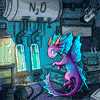
Philophana reading - By Blindcoyote
 Blindcoyote allowed me to commission a quick take on my clockwork "moffy"™ girl.
Blindcoyote allowed me to commission a quick take on my clockwork "moffy"™ girl.Great artist, a pleasure to work with! 5/7 would commission again. ❤
Here we see Philophana in her natural environment. Reading a book. Candle light not provided because this was a sketch and not a 30 hour rendering... but imagine it's somewhere there, behind you, in the direction she's looking at. 😝
Jokes aside, i love this piece's relaxed atmosphere and the quizzical expression of Philophana.
• Support the artist here: https://www.patreon.com/BlindCoyote/overview
• Artist Page: https://www.blindcoyote.com/
• Commission Info: https://www.blindcoyote.com/prices/
Philophana by
 forgess
forgess• Support the artist here: https://www.patreon.com/TheMonsterForge
• Artist Page: https://www.furaffinity.net/user/forgess
• Commission Info: http://pre04.deviantart.net/cc46/th.....ss-day4jjx.jpg
SONGBIRD™ "race" by
 tegerio
tegerio• Support the artist here: https://www.patreon.com/tegerio
• Artist Page: https://www.furaffinity.net/user/tegerio
• Commission Info: https://www.furaffinity.net/commissions/tegerio/
Category Artwork (Digital) / Portraits
Species Insect (Other)
Size 900 x 1260px
File Size 111.5 kB
This raises all kinds of questions. How could a mechanical clockwork "brain" understand or even remember what it had read? How much memory capacity can there be in a device where every bit of data is a physical switch?
I'd be willing to suspend disbelief that a Songbird™ could read aloud (optical character recognition, word parsing, voice synthesis) which even in itself would be an INCREDIBLE feat of engineering. But an automaton reading for its own "enjoyment"? Too much.
Unless you want to openly acknowledge the use of magic, that there is a demon or a ghost inhabiting the core of this device .. but I thought the whole point of this was that it was a non-magical "marvelous machine".
I'd be willing to suspend disbelief that a Songbird™ could read aloud (optical character recognition, word parsing, voice synthesis) which even in itself would be an INCREDIBLE feat of engineering. But an automaton reading for its own "enjoyment"? Too much.
Unless you want to openly acknowledge the use of magic, that there is a demon or a ghost inhabiting the core of this device .. but I thought the whole point of this was that it was a non-magical "marvelous machine".
Philophana is canonically magic. Yes. 😝👍💖
But to answer your question. Clockwork data storage systems not only existed but were:
- Rewritable (by the machine itself, if needed).
- Somewhat Analog (while technically analog, they still tended to then rely on ratios or rationally quantized movements).
- very small in capacity but usually high value of values per "bit".
They worked via movable pins (of varying height) on a disk/cilinder, or gears with removable/switchable teeth, each tooth of varying height.
They usually allowed the machine to have some for of long term memory read by a fixed "program" so to speak.
There was also a form of "cache" used via sounding of mercury tubes (the bouncing of the pressure waves was used to "store" information but only for the time needed until it bounced back) which was later used by the very first electrical computers too.
The world of analog computing is now a rather forgotten science, but was very interesting for what i've read.
But aside from author-specific appearance variations, there are (for now) only 2 known SONGBIRDs™. Philomela and Philophana.
Philophana is canonically bonker bogus or straight up magic. The canonical Philophana SONGBIRD™ story, sees her as a straight up thinking being from the start, with dreams, and everything, striving to get hired as an actress, and failing multiple times before finally getting her dream (yes, it's somewhat similar to Dulcibella's story). Somewhat of a comedy, somewhat serious, i'm still unsure if i want to go for the comedy of tragedy or... the normal comedy. There's even a ridiculous scene specifically designed to show how she's a literal impossible machine that can power herself on account of moving, like those automatic clocks. Aaaand not only that violates the 2nd law, but since she passes a lot of time studying and/or reading... that would need waaaaaaaay more than 100% efficiency in recycling the energy of movement. 😝👍💖 I love bogus fiction.
Philomela is canonically "suspension of disbelief real". As you stated (at least once), all the drawings and the pieces of art where she is more than an unthinking clockwork machine are either dream sequences or promotional material, or straight up alternate realities with magic involved, because why not? Take your pick. In the canonical Philomela SONGBIRD™ story, which i've finished, the inventor strives for those dreams or letting her do what the promotional material claims (ah... the unregulated advertisement wonders of the 1920s), it's never said if she's just a machine pre-programmed to do one thing or if she can actually think. Everything points to the inventor just doing what's already been written in the manual and getting a very specific result before having to sell her on account of having lost a fortune following his dream, and his workshop being now unsalvageable. Once sold, the original nightingale story then follows, where she basically works for a couple of times singing around then breaks down and nobody is able to repair her, and the end result is the museum exposition by Honovy.
But to answer your question. Clockwork data storage systems not only existed but were:
- Rewritable (by the machine itself, if needed).
- Somewhat Analog (while technically analog, they still tended to then rely on ratios or rationally quantized movements).
- very small in capacity but usually high value of values per "bit".
They worked via movable pins (of varying height) on a disk/cilinder, or gears with removable/switchable teeth, each tooth of varying height.
They usually allowed the machine to have some for of long term memory read by a fixed "program" so to speak.
There was also a form of "cache" used via sounding of mercury tubes (the bouncing of the pressure waves was used to "store" information but only for the time needed until it bounced back) which was later used by the very first electrical computers too.
The world of analog computing is now a rather forgotten science, but was very interesting for what i've read.
But aside from author-specific appearance variations, there are (for now) only 2 known SONGBIRDs™. Philomela and Philophana.
Philophana is canonically bonker bogus or straight up magic. The canonical Philophana SONGBIRD™ story, sees her as a straight up thinking being from the start, with dreams, and everything, striving to get hired as an actress, and failing multiple times before finally getting her dream (yes, it's somewhat similar to Dulcibella's story). Somewhat of a comedy, somewhat serious, i'm still unsure if i want to go for the comedy of tragedy or... the normal comedy. There's even a ridiculous scene specifically designed to show how she's a literal impossible machine that can power herself on account of moving, like those automatic clocks. Aaaand not only that violates the 2nd law, but since she passes a lot of time studying and/or reading... that would need waaaaaaaay more than 100% efficiency in recycling the energy of movement. 😝👍💖 I love bogus fiction.
Philomela is canonically "suspension of disbelief real". As you stated (at least once), all the drawings and the pieces of art where she is more than an unthinking clockwork machine are either dream sequences or promotional material, or straight up alternate realities with magic involved, because why not? Take your pick. In the canonical Philomela SONGBIRD™ story, which i've finished, the inventor strives for those dreams or letting her do what the promotional material claims (ah... the unregulated advertisement wonders of the 1920s), it's never said if she's just a machine pre-programmed to do one thing or if she can actually think. Everything points to the inventor just doing what's already been written in the manual and getting a very specific result before having to sell her on account of having lost a fortune following his dream, and his workshop being now unsalvageable. Once sold, the original nightingale story then follows, where she basically works for a couple of times singing around then breaks down and nobody is able to repair her, and the end result is the museum exposition by Honovy.

 FA+
FA+











Comments